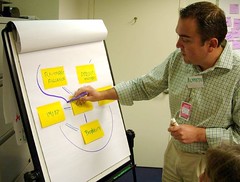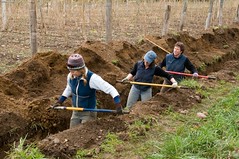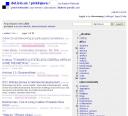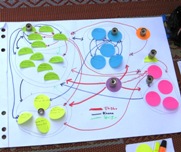 I often use a variety of paper networking mapping exercises in my face to face workshops. These have been valuable because the maps help people visualize their work networks in new ways, and the conversation around the maps — especially getting others’ perspectives — helps us see our own maps in new ways and then be more strategic in the use of our networks.
I often use a variety of paper networking mapping exercises in my face to face workshops. These have been valuable because the maps help people visualize their work networks in new ways, and the conversation around the maps — especially getting others’ perspectives — helps us see our own maps in new ways and then be more strategic in the use of our networks.
In an upcoming online workshop on knowledge sharing for the CGIAR, we want to do this exercise online — and we want to keep technology low key as this is at the start of the workshop and some participants are not as techy as some of us! 😉 So I’m trying to figure out how to do it. I really like the Net-Map process, but it is more in depth than we want to go for this introductory activity.
Would you help me and try it out? I’ve altered the instructions here so we can do it right in the blog, but it will actually be done inside a Moodle installation.
Activity: Map Your Network
Brief Description:
This activity offers and introduction to social network mapping. Using paper, pens and post-it notes, you can create an informal map for your network and then discuss it with others in and outside of your network. Discussing with your network partners offers their perspective of how they fit into your network, which you may not always easily see. Discussing with workshop participants gives you a chance to see the diagram from another’s point of view. Together, these help inform your strategy for working with and sharing knowledge with those in your network.
Purpose:
- Understand a simple application of social network mapping
- Consider how best to utilize your network for your project
- Use the multiple perspectives of others to improve your understanding of your network
Materials:
- 2-3 pieces of flip chart paper
- Small Post-It notes (or pieces of paper and tape)
- Pencil
- Marker pens (2-3 colors)
- Digital camera
Steps:
1. Think of a project that you are working on that requires knowledge sharing. Ideally, this is a real project and one you will be working on throughout the workshop. (For our test, pick one of your networks!)
2. List all the people and organizations involved with your project, putting each one on a small Post-It note. We’ll call these “notes” from now on.
3. Create a note that represents you or your immediate working group or organization.
4. Starting with your note, arrange the notes on the flip chart paper. Place the other notes in relationship to you and your organization. In other words, people or organizations you most frequently do things with should be closer to your note than ones you only interact with infrequently. If your work is all internal, consider other departments, etc.
5. If people or organizations on the notes have relationships or interactions with each other, try and place those notes closer to each other. Move the notes around until you have a general sense of how each person/organization relates to you and to the other notes.
6. Now with a pencil, draw an arrow from you to any of the other people/organizations to whom you regularly share knowledge. The direction of the arrow should be from your note to their note. Then draw lines from other people/organizations who regularly give you information or share knowledge (or you WISH they would!). This time the direction of the arrows should be from them to you. Finally, repeat this process for where other people/organizations share knowledge with any of the other people/organizations. You should now have a set of penciled, directional lines.
7. Now, look at the network again. After thinking about the knowledge flows, do you want to reorganize the notes in any new arrangement? Is there a clumping of some people/organizations? Are some with few or no pencil lines and should be moved further away from your note? Go ahead and move them.
8. With your rearranged notes, draw in the knowledge sharing flow lines in pen. Put the flow from you to others in one color, and from others to you in a second color. Add a third, dotted line between any post its where there are the strongest connections. These identify primary connections in the network.
9. Take a moment to step back and look at your map. What do you notice?
a. With whom do you have the strongest knowledge sharing connections (two way arrows and dotted lines)?
b. With whom do you THINK you should have the strongest connections? If they are not the same as (a) what might you do to strengthen them?
c. Who is an important knowledge intermediary or connector in your network? These would be people/organizations who have lots of connections with other nodes. Which have very few connections and what are the implications for your work?
d. What might you do to strengthen weak connections? To manage where you have too many connections? If you are the only current ‘connector’ who else might help play that role?
10. If you have time, show your map to someone in your network and see what they see when they look at it. Make a note of their observations and any changes they might suggest.
11. Take a digital picture of your network image. Post it on Flickr or some other website and post a link in a comment to this blog post. Share anything you learned in your observations from steps #9 and #10.
12. Look at the maps of others, their observations and give your perspective on at least one other person’s map. A workshop facilitator will also offer their observations, so everyone will get some feedback.
13. After you have received feedback, post a short reflection in your Learning Log on the Moodle site about any insights you had about your network and how you can best use it for your work. (FEEL FREE TO DO THAT HERE IN ANOTHER COMMENT).
DEEP appreciation and thanks in advance for playing along.
Edited later: I have made a few tweaks, fixed some typos, all with the help of my friends. Photos of Twitter friends’ feedback via Flickr here. See also some early thoughts here.
Edited even later: Here is a Short Podcast with Patti Anklam on “Why Map our Networks?”


 If you are interested in social network mapping, subscribe to Eva Schiffer’s blog, the
If you are interested in social network mapping, subscribe to Eva Schiffer’s blog, the 